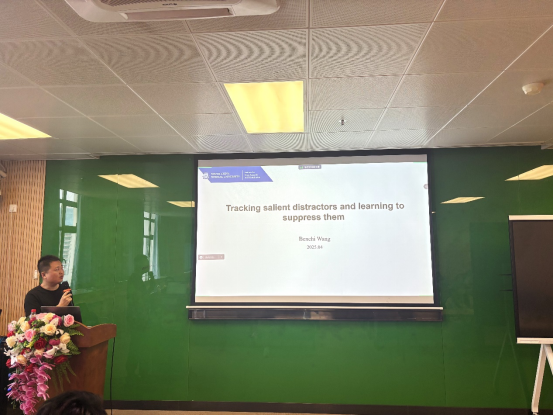On the morning of April 8th, Associate Researcher Wang Benchi from South China Normal University delivered a lecture at the School of Psychology, Shenzhen University, titled “Tracking Salient Distractors and Learning to Suppress Them.” In his talk, Dr. Wang shared a series of studies on attentional cognition with the faculty and students, offering valuable insights into attentional capture and the neural mechanisms underlying distractor suppression.

Dr. Wang Benchi first systematically explored the neural processing mechanisms of salient distractors in the brain and the cognitive strategies for their suppression. He then shared the latest research findings from his team. Utilizing intracranial EEG (iEEG) in combination with visual search tasks, his team was the first to track the neural representation of distractor signals in the human brain. They discovered that high-frequency activity (HFA) significantly increased approximately 200 milliseconds after the appearance of a distractor. Moreover, key brain regions such as the anterior cingulate cortex (ACC), temporal lobe (STG/MTG), and amygdala were found to collaborate in processing distractors, challenging the traditional “lateral attention network” hypothesis.Through model decoding techniques, the team further demonstrated that distractor signals emerged earlier than target signals and exhibited greater intensity, suggesting that the brain has a “priority response” to distractors.
Secondly, the research delved into the role of statistical learning in distractor suppression. Through probability learning, the team found that repeated presentation of distractors gave rise to a spatial gradient effect—that is, suppression effects at high-probability locations could spread to adjacent areas. This process was shown to be implicit, yet its spatial information could still be precisely represented in neural signals such as alpha-band oscillations.More importantly, the team proposed that low-frequency neural oscillations convey spatial regularities through phase coding, forming a dynamic “priority selection map.” This discovery offers a novel perspective on how the brain internalizes environmental regularities.
The study then integrated eye-tracking and EEG data to illustrate the dynamic relationship between attention and suppression. Results revealed that effective suppression of distractors requires an initial attentional shift—via microsaccades—toward the distractor location, which then triggers the suppression mechanism. This suggests that attention is a prerequisite for suppression.Moreover, alpha-band oscillations were found to play a dual role: they are involved in early attentional selection, and also maintain the encoding of spatial regularities through phase synchronization. This finding reconciles previous debates regarding the function of alpha oscillations, highlighting their strategic role in cognitive control.
Finally, the Q&A session helped further clarify details of the research. For instance, the choice to focus on the N2pc component rather than P300 was due to its more direct reflection of early attentional selection. Additionally, while stimulus familiarity may accelerate the internalization of regularities through statistical learning, this hypothesis requires further validation.